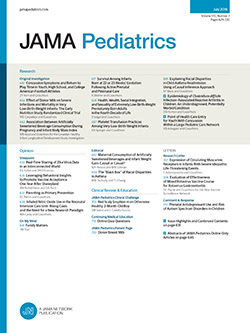1型糖尿病儿童和青少年的自动胰岛素输送系统和血糖管理:系统综述和荟萃分析
IF 18
1区 医学
Q1 PEDIATRICS
引用次数: 0
摘要
越来越多患有1型糖尿病(T1D)的年轻人选择自动胰岛素输送(AID)系统来控制他们的血糖。很少有随机临床试验(rct)的系统评价meta分析结果可用于指导决策。目的研究门诊长期使用AID系统与青年T1D患者血糖管理和生活质量的关系。检索2017年1月至2025年3月的medline、Embase、CINAHL和Cochrane Central,以确定符合条件的rct。研究选择两名审稿人独立进行文献筛选、数据提取和质量评估。分析中纳入了6至18岁T1D青年的随机对照试验,评估了与其他胰岛素方案相比,AID系统在门诊环境中使用时间超过48小时的疗效。数据提取和综合两名审稿人独立进行数据提取和质量评估,并使用系统评价和荟萃分析首选报告项目(PRISMA)和PRISMA文献检索扩展指南进行报告。随机效应荟萃分析模型用于估计疗效的合并测量值,即平均差异(MD),结果测量值为95% ci。2个主要结局指标是持续时间(TIR)和糖化血红蛋白(HbA1c)。结果在检索到的2363篇引文中,纳入了11项HbA1c测量的rct (n = 901名受试者)和10项TIR测量的rct (n = 786名受试者)。随机对照试验对中位年龄为12岁(范围10.8-15.9岁)的青少年进行了干预,平均(SD)持续31(26)周;51%为女性,平均(SD) HbA1c水平为8.4%(1.1%),平均(SD) TIR为51%(9%)。随机效应模型显示,与任何胰岛素方案相比,HbA1c水平降低了-0.41% (95% CI, -0.58%至-0.25%;I2 = 39%),而TIR增加了11.5% (95% CI, 9.3%-13.7%; I2 = 23%),夜间TIR增加了19.7% (95% CI, 17.0%-22.4%; I2 = 36%)。随机效应模型还显示,与任何胰岛素治疗方案相比,AID的使用与低血糖持续时间缩短相关(10 mmol/L; MD = -10.8%; 95% CI, -14.4%至-7.2%;I2 = 55%),特别是在夜间(MD = -14.4%; 95% CI, -19.9%至-8.9%;I2 = 79%)。研究组之间的不良事件没有差异。只有2项研究报告了生活质量的变化。本系统综述和荟萃分析发现,与任何其他胰岛素方案相比,青年T1D患者使用AID系统与多种血糖管理指标的临床有意义的改善相关,包括高血糖和低血糖的风险,而不会增加不良事件的风险。需要更多关于艾滋病系统对患者报告结果的有效性的数据。本文章由计算机程序翻译,如有差异,请以英文原文为准。
Automated Insulin Delivery Systems and Glucose Management in Children and Adolescents With Type 1 Diabetes: A Systematic Review and Meta-Analysis.
Importance
Youth living with type 1 diabetes (T1D) are increasingly choosing automated insulin delivery (AID) systems to manage their blood glucose. Few systematic reviews meta-analyzing results from randomized clinical trials (RCTs) are available to guide decision-making.
Objective
To study the association of prolonged AID system use in an outpatient setting with measures of glucose management and quality of life in youth with T1D.
Data Sources
MEDLINE, Embase, CINAHL, and Cochrane Central were searched from January 2017 to March 2025 to identify eligible RCTs.
Study Selection
Two reviewers independently performed literature screening, data extraction, and quality assessment. Included in the analysis were RCTs of youth aged 6 to 18 years with T1D that assessed the efficacy of AID systems in outpatient settings longer than 48 hours compared with any other insulin regimen.
Data Extraction and Synthesis
Two reviewers performed data extraction and quality assessment independently and reported using the Preferred Reporting Items for Systematic Reviews and Meta-Analyses (PRISMA) and PRISMA literature search extension guidelines. Random-effects meta-analysis models were used to estimate the pooled measures of efficacy as a mean difference (MD) with 95% CIs for outcomes measures.
Main Outcomes and Measures
The 2 primary outcome measures were time in range (TIR) and glycated hemoglobin (HbA1c).
Results
Of 2363 citations retrieved, 11 RCTs (n = 901 participants) with measures of HbA1c and 10 RCTs (n = 786 participants) with measures of TIR were included. RCTs tested interventions lasting a mean (SD) of 31 (26) weeks on youth with a median age of 12 years (range, 10.8-15.9 years); 51% were female, mean (SD) HbA1c level was 8.4% (1.1%), and mean (SD) TIR was 51% (9%). Random-effects models revealed that, compared with any insulin regimen, HbA1c level was reduced -0.41% (95% CI, -0.58% to -0.25%; I2 = 39%), whereas TIR increased 11.5% (95% CI, 9.3%-13.7%; I2 = 23%) with nighttime TIR increasing 19.7% (95% CI, 17.0%-22.4%; I2 = 36%). Random-effects models also revealed that AID use was associated with reduced time spent in hypoglycemia (<3.9 mml/L; MD = -0.32%; 95% CI, -0.60% to -0.03%; I2 = 18%) and hyperglycemia (>10 mmol/L; MD = -10.8%; 95% CI, -14.4% to -7.2%; I2 = 55%), particularly during the night (MD = -14.4%; 95% CI, -19.9% to -8.9%; I2 = 79%) compared with any insulin regimen. There were no differences in adverse events between study arms. Only 2 studies reported changes in QOL.
Conclusions and Relevance
This systematic review and meta-analysis found that compared with any other insulin regimen, use of AID systems by youth with T1D was associated with clinically meaningful improvements in multiple measures of glucose management, including the risk of both hyperglycemia and hypoglycemia, without increasing the risk of adverse events. More data are needed on the efficacy of AID systems on patient report outcomes.
求助全文
通过发布文献求助,成功后即可免费获取论文全文。
去求助
来源期刊

JAMA Pediatrics
PEDIATRICS-
CiteScore
31.60
自引率
1.90%
发文量
357
期刊介绍:
JAMA Pediatrics, the oldest continuously published pediatric journal in the US since 1911, is an international peer-reviewed publication and a part of the JAMA Network. Published weekly online and in 12 issues annually, it garners over 8.4 million article views and downloads yearly. All research articles become freely accessible online after 12 months without any author fees, and through the WHO's HINARI program, the online version is accessible to institutions in developing countries.
With a focus on advancing the health of infants, children, and adolescents, JAMA Pediatrics serves as a platform for discussing crucial issues and policies in child and adolescent health care. Leveraging the latest technology, it ensures timely access to information for its readers worldwide.
 求助内容:
求助内容: 应助结果提醒方式:
应助结果提醒方式:


